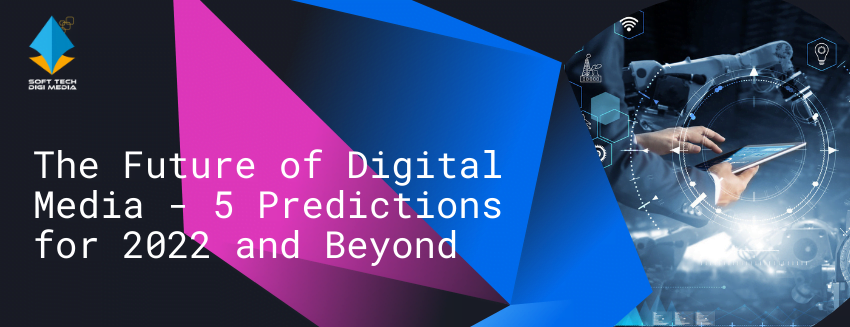
Future of the Digital Media
How many times have you been scrolling through your Facebook feed and seen the same ten ads over and over again? It’s likely that this same phenomenon has happened to you on other social media sites, as well as when browsing through Google search results or any other website that provides digital media. Digital media is growing rapidly, but how will it continue to evolve? What are some key changes we can expect to see in the future? To find out, read this list of five predictions about digital media in 2022.
A. The Rise of Digital Growth Will Continue
According to eMarketer, digital advertising spending will jump from $72 billion in 2017 to $200 billion by 2022. Digital media will make up 45% of all media spend in three years, an increase from 36% in 2017. What’s more, 83% of advertisers are projected to use programmatic buying (automated digital ad purchases) in 2018—marking a nearly 12-point increase since 2017. As digital grows as a channel for brands and publishers alike, marketers should stay abreast of new trends and technology that can expand campaign reach and effectiveness. Following best practices for digital media, attribution is one way to do so. If a marketer knows exactly how much revenue was generated through different channels, they can optimize budgets accordingly. One example: Influencer marketing on Instagram is one of few ways to boost direct sales through social ads; but only if attribution settings allow you to track conversions that come as a result of following influencers on Instagram or engaging with their content there.

B. Influencers are Becoming the New Brands
When creating a new brand, you’re going to have to dig deep into your marketing playbook. In today’s content-driven digital world, it’s not just about creating a product or service anymore. It’s also about creating a compelling narrative around that product or service and then funneling that narrative through influencers and social media. Startups who can pull off an effective influencer strategy are on their way to becoming tomorrow’s big brands. According to Forbes, in 2019 social media will account for 52% of all digital advertising. You better get cracking! So how do you start? Start with your customers. Try out specific strategies like community outreach, Snapchat campaigns, and Instagram stories with free giveaways to gauge which paths work best for you, then measure every single step along the way so that it becomes part of your bigger plan: #GrowthForTheWin! Google has announced its intention to integrate email inboxes directly with both G Suite and Gmail apps on Android devices by moving towards a unified architecture.
C. Mobile Marketing is Growing Exponentially
The growth of mobile technology, such as smartphones and tablets, has made mobile marketing one of today’s fastest-growing industries. Digital media professionals have taken note and continue to invest heavily in developing new strategies and creativity to deliver engaging content across a variety of devices. The rise in appification is just one example that shows how digital media is constantly evolving. Expect digital media to continue its growth as an industry over the next five years and beyond as more consumers adopt these technologies. By 2022, eMarketer estimates there will be 3 billion Internet users around the world—up from 2.3 billion in 2015—and nearly 1 billion Internet users will be accessing via mobile devices (see chart below). This means brands will need to figure out ways to engage with digital audiences on their phones or risk losing them altogether.
D. Advertising Is Evolving
In 2018, digital ad spending exceeded TV advertising in terms of total revenue. The sheer size and scope of digital media have allowed it to outperform traditional media channels in nearly every category—and that’s why it’s poised to keep growing at a breakneck pace. We predict that digital spending will surpass $500 billion by 2022. For perspective, there was an estimated $320 billion spent on TV ads in 2017, so we are talking about significant growth over just 5 years. As our lives become more connected through smart devices (the global internet-of-things market is expected to reach 1 trillion devices in 2020), digital marketing has never been more impactful. This shift toward digital media also gives advertisers direct access to consumers as opposed to paying for space on a third-party platform. This direct line of communication gives marketers access to multiple data points that inform their decision-making.
E. There Are Going to be More Opportunities than Challenges
Even with intense competition, digital marketing isn’t going anywhere. According to a study from eMarketer, worldwide mobile ad spending is expected to grow from $77 billion in 2015 to $142 billion in 2018—and that includes all mobile ad formats, not just digital video. Video’s share will grow from 27 percent in 2015 to 33 percent by 2018. This year alone, marketers are predicted to spend $6.7 billion on Internet video ads and more than double that by 2019 (the bulk of which will be spent on highly-targeted mobile formats). This means more opportunities than ever before—for brands and agencies alike. The market is moving online, so digital media companies need to leverage every channel at their disposal to reach consumers in every moment—and build meaningful relationships with them along the way. In fact, Google has already seen a 10x increase in how long viewers engage with their videos since 2013; it’s only going to continue getting better from here.
